 Download as .pdf Document
Download as .pdf Document
|
S E E N I N K O R E A "Saucers" Seen Over Korea
By United Press
The Air Force disclosed today that objects resembling “flying discs” have been sighted over Korea by crew members of two U. S. bombers.
Top officials have ordered a full investigation of the reports, which came thru regular military intelligence channels.
A spokesman said the objects were described by four eyewitnesses as globe-shaped, bright orange in color and emitting an occasional flash of bluish light.
He indicated that several were sighted, but did not give the number.
The Air Force, which has thrown cold water on hundreds of previous “flying saucer” stories, apparently was impressed by circumstances under which the new sightings were reported by its own personnel.
PARALLEL TO PLANE
The first report reached Air Force intelligence officers from two crew members of a B-29 Superfortress who said they saw the objects flying parallel to their plane at about midnight on the night of Jan 29. The plane was over Wonsan, Korea at the time.
The report might have been discounted as over-imaginative. But on the same night, a B-29 from a different squadron returned to its base after a flight over Sunchon, Korea, a considerable distance from Wonsan. Two crew members told intelligence officers that they had seen "flying discs" moving parallel to their plane at a high altitude.
ATTITUDE A CONTRAST
"The objects remained with the B-29 over Wonsan for five minutes and with the B-29 over Sunchon for one minute," the Air Force said.
While officials declined to elaborate on the bare announcement that a full investigation is underway, the open-minded Air Force attitude toward the new reports contrasted with the blunt skepticism it has voiced about previous sightings of mysterious objects in the skies.
The Wonsan/Sunchon incident was mentioned in Edward J. Ruppelt’s
1956 book, The Report on Unidentified Flying Objects. The
unpublished manuscript provides more detail of the official
reaction to the sightings. Both versions are presented below:
[Published version:]
Ever since the new Project Grudge had been organized, we hadn’t had
to deal with any large scale publicity about UFO’s. Occasionally
someone would bring in a local item from some newspaper about a UFO
sighting, but the sightings never rated more than an inch or two of
column space. But on February 19, 1952, the calm was broken....
[Here a partial hand-written line was inserted into the final
version to compensate for the removal of more than a page of text
from the manuscript]
....by a story of how a huge ball of fire paced two B-29 in Korea.
[Published version]
The story didn’t start a rash of reports like the story of the first
UFO sighting did back in June 1947, but it was significant in that
it started a slow build-up of publicity that was to far surpass
anything in the past.
[Unedited original Manuscript version:]
The story was about a sighting in Korea. ATIC had received the
report about two weeks before, and it was in the process of being
analyzed when the story broke. When the report came into ATIC, it
was classified Secret, but two weeks later it appeared in the
newspapers word for word and it had never been declassified.
Evidently the reporters’ “usually reliable sources” were reliable.
The sighting had occurred on the night of January 29. At 11:00 PM a
B-29 crew was flying south returning from a bombing mission in
Northern Korea. They had just passed through an area where they'd
picked up a little flak and some searchlights, but they’d gotten
through untouched. When they were about 30 miles west southwest of
Wonsan, a town about 80 miles north of the 38th parallel on the east
coast of Korea, one of the gunners called out a light “at 8 o’clock
level.” The aircraft commander told him to keep an eye on it. He did
and in a matter of seconds it had moved in. For five minutes the
crew watched a huge ball of churning, swirling fire as it paced the
B-29. Then almost as swiftly as it had appeared, it dropped down a
little, swung in under the big bomber and streaked away to the west.
Twenty-four minutes later a second B-29 crew flying near Sunchon,
about 90 miles northwest of where the first sighting had taken place,
had an almost identical experience. But this time the ball of fire
only stayed for a minute.
By the time we got the report at ATIC, the two B-29 crews had been
interrogated by a dozen different FEAF intelligence officers.
At first FEAF intelligence officers thought that possibly this was
a case for “the power of suggestion,” but the two crews had made
independent reports — neither crew knew about the other's sightings.
The crew were reinterrogated, but they couldn’t add any more to their
original story. The UFO was just a big, spherical mass of swirling
fire — “like the color of the sun.” It had fuzzy edges and all of
the observers stressed the fact that the fiery mass had an “internal
churning motion.” The estimate of relative size varied from “a golf
ball held at arm's length” to “an automobile.”
Project Grudge's new policy of giving out all of the answers to the
press to dispel any feeling of hidden intrigue or mystery about the
UFO project almost fell flat on its face at the start. The sighting
was listed as “unknown” but since it occurred in a combat zone and
could have been a new enemy weapon, as well as a UFO or some natural
phenomenon, all we could give the press was a “no comment” answer.
We did explain the reason for our “no comment,” however, the press
was happy.
[It appears this last phrase should actually read “the
press was not happy.”]
Project 1947 comments:
Suddenly, without warning, news stories on
the Wonsan-Sunchon incidents appeared in the press across the United
States and the world on 19 February, 1952. The above United Press
wire service story appeared in The Washington Daily News City
edition on 19 February, 1952. The first page had a three line
headline which took up one third of the tabloid's front page.
The USAF Directorate of Intelligence and USAF Public Relations Office in Washington, D. C., the “New” Project Grudge at Air Technical Intelligence Center (ATIC) at Wright-Patterson Air Force Base in Dayton, Ohio, and the Far East Air Force (FEAF) Headquarters in Tokyo, Japan were all caught completely flat-footed by the leak. The source of the leak has never been identified, but must have been highly placed given the classified nature of the 29/30 January sighting reports. A story with large front page sensationalism appeared in many cities, but in Washington, D. C. such a story was bound to catch the attention of government, military and Congress members. The media attention resulted in a scramble by the USAF to come up with answers for superiors, the media, and finally Senator Richard Russell, powerful chairman of the Senate Armed Services Committee. As General Twining stated in his letter to the Secretary of the Air Force, the news stories carried incorrect information and media interpretations. It did, however, bring the news to the Public's attention and they looked to the government for answers. While Air Force intelligence suggested exhaust from Communist fighter aircraft as an answer for Senator Russell, ATIC advanced the phenomenon known as “foo-fighters” to visiting Life magazine writer, Robert Ginna, which was later communicated to the public in April, 1952, in a long article, “Have We Visitors from Space?” |
|
1. Request for more information and questions about the UFO sightings go out from ATIC on February 1 to the D/I with a request to pass the details on to FEAF HQ, Tokyo. |
|
FROM: (Originator) CO, ATIC
|
DATE-TIME GROUP 0119452 Feb 52 ACTION ROUTINE
|
|
|
TO: D/I HQ USAF WASH DC | ||
|
INFO:
FROM: ATIRC1, WOODALL FOR: AFOIN-C/CC, PARKER PASS TO CG, FEAF
Reference your message A 1925 dated 310956Z re B-29 crew sighting of
unidentified flying objects. Request that answers to following
questions be forwarded immediately:
(1) Geographical coordinates of location of sighting. (2) Altitudes, headings and air speeds of two aircraft at time of sighting. (3) Which direction did objects appear to be rotating? (4) Were times object was in sight estimated or timed in some way? (5) Why did object appear to be a disk; was it observed both edgewise and flat? (6) What was length to thickness ratio? (7) Have photo interpreters noticed anything on the ground similar to reported object? Suggest that all combat crews be briefed to be alert for more such incidents and attempts be made to obtain photos. Further suggest that all fire control officers be briefed on the feasibility of making rough estimations using two sighting stations and approximations of size in comparison with reticle center dots. Dot is estimated to be two (2) mile. Reference all replies to AMC-3117-C |
||
COORDINATION: T52-2999-4 PAGE 1 of 1 PAGES |
||
|
DRAFTERS NAME (and signature when required)
R.L. Woodall/jb
|
RELEASING OFFICER'S SIGNATURE
KENNETH T. FINCH
CAPTAIN U.S.A.F. Asst Air Adjutant General |
|
|
SYMBOL
ATIRC1
|
TELEPHONE 55101
|
|
|
2. On 4 February, ATIC sends a routine message for Brig. General Garland (AFOIN-A) at D/I that ATIC has considered the possibility that the UFOs could be jet exhaust, afterburner exhaust or vortex in the airstream, a Ramjet helicopter, or an air-to-air weapon dropped from higher altitude; however, all the proposed explanations seem weak. "Fireballs" i.e., "foo-fighters" were mentioned and trailed bombs considered. It was also suggested that aircrews be alerted to possible repetitions of the sightings and to use their targetting equipment to gather additional data about the unknown objects. |
| AUTH: CO, ATIC INITIALS: Col R.W. Taylor DATE: 4 February 1952 |
||
|
FROM: (Originator) CO, ATIC
|
DATE-TIME GROUP 41700Z Feb 52 ACTION ROUTINE
|
|
|
TO: Director of Intelligence Headquarters USA Washington 25, D.C. | ||
|
INFO:
ATTN: AFOIN-A Subject: Comments on FEAF Observations of Unidentified Objects,
20 Jan 52. Reference above subject and telephone conversation between the
undersigned and Col Sherman on 1 Feb, following possibilities considered: (a) Exhaust
stack flare from aircraft running rich. Considered doubtful because no known Soviet
aircraft have exhaust stack arrangement that would produce this illusion.
(b) Jet aircraft engine or afterburner exhaust. Considered doubtful because it is thought such an exhaust would have been recognized and identified by observers. (c) Vortex in airstream. Considered doubtful because of time of sighting and description of object as colored. (d) Ramjet helicopter. Considered doubtful because of the unlikelihood of the presence of any such aircraft at the altitude and in the positions given, and because of the comparatively slow forward speed such an aircraft would possess. (e) Air-to-air weapon in the form of sheet metal discs dropped from higher altitude. Germany was known to have had such a development during World War II. Such a weapon might well have the disc-shaped appearance and the spinning motion described, and it might also either be illuminated or
T-52-3047-1
cont'd
reflecting illumination from some other source. However, the description of the object sighted as having maintained a position parallel to the sighting airplane for some time, would seem to eliminate this possibility. It is therefore considered doubtful, although somewhat less so than other possibilities mentioned above. (f) "Fireballs." These phenomena made their appearance over both Germany and Japan during World War II. They have never been completely explained, and there is no record of aircraft having been damaged by them. One evaluation is that they may have been flying bombs launched either from the ground or from aircraft, and that the characteristic fiery glow was the exhaust of the powered missile. Another is that they may have been ground-launched rockets containing illuminating or incendiary agents that drifted downward on parachutes. Some such weapon or a development of it is considered a fair possibility in this case. (g) Trailed bombs. This weapon was developed in 1942 by Germany, and in its original application was intended as a defense by bombers against persuing (sic) fighters. It consisted of a bomb of 20 to 25 kg in weight attached to a wire some 100 to 250 metres long, finned to cause
T-52-3047-2
cont'd
the execution of wide swinging circles behind the bomber when the wire was paid out from the bomber's tail. It could be exploded at will by a crew member of the bomber. A variation of this weapon that may have been intended for use against bombers, was a cylindrical object trailed by wires from a Ju.88. Such a weapon would appear circular or disc-shaped, might well take on a spinning motion when trailed, might be illuminated or reflect light, and might for a time, parallel the course of an aircraft attached; for these reasons it is considered a fair, or perhaps even a good, possibility. FEAF has been requested to supply additional details of sightings, and to alert all aircrews to watch for repetitions. The suggestion has also been made that crews attempt to measure distances, angles, size, etc. by a system employing Central Fire Control equipment. Signed, Air Technical Intelligence Center |
||
COORDINATION: T52-3047-2 PAGE 3 of 3 PAGES |
||
|
DRAFTERS NAME (and signature when required)
Lt Col Ray W. Taylor/im
|
RELEASING OFFICER'S SIGNATURE
FRANK L. DUNN, Colonel, USAF
OFFICIAL TITLE Chief, Air Technical Intelligence Center |
|
|
SYMBOL
ATI
|
TELEPHONE 55210
|
|
|
3. HQ, USAF relayed FEAF's answers to item #1. Observers provided clarification on the shape of the objects; globular rather than flat (disk-like). Also suggestions in item #1 were relayed to FEAF Bomber Command. |
|
AIR 017 AF AIR 017 AFM DE AIR RR JEDWP DE JEPHQ 76C FM HQ USAF WASHDC TO HQ AMC WPAFB OHIO FROM CG FEAF TO HQ USAF QUOTED FOR YOUR INFO QUOTE REUR CITE AMC 3117 C 5 FEB (1) FIRST OBS 390 IN/12708E ALT 22250 HDG 289 DEG GRD SPD 125 KTS; (2) BRILLIANCE AND SHIMMERING OF LIGHT SUGGESTED SPINNING OR ROTATION, BUT OBRS COULD NOT STATE DEFINITELY APPARENT MOVEMENT WAS ACTUAL; (3)-(OMITTED FROM MESSAGE), (4) ESTIMATED; (5) ON RE-INTERROGATION OBSRS DESCRIBED OBJS AS GLOBULAR RATHER THAN FLAT AND DESCRIPTION GIVEN INITIAL REPORT AS SAUCER SHAPED INTENDED TO INDICATE ROUNDNESS WITHOUT REFERENCE TO DEPTH OR THICKNESS. OBJS NOT OBSRD EDGEWISE AND LAT BUT ONLY WITH LINE OF SIGHT PERPENDICULAR TO PLANE OF OBJS; (6) NOT POSS TO EST; (7) NEGATIVE. PAGE TWO JEPHQ 7 6C SUGGESTIONS CONTAINED YOUR MSG HAVE BEEN FORWARDED TO FEAF BOMCOM. FEAF BOMCOM MSG BOX 5447 D/I, 6 FEB 52 ALSO APPLIES. END QUOTE. T52-4222-1 |
|
4. FEAF Bomber Command, Yokota, Japan, provides details of the original sighting to D/I, ATIC and Air Defense Command at Ent Air Force Base, Colorado. This report was delayed due to servicing of the communication equipment. |
|
This msg delayed due to servicing. Fm FEAF Bomber Comd Yikota [Yokota] Japan To AMC WPAFB Ohio, For Chief Air Tech Intel Center Adf Ent AFB Colo For CG ADF Info CS USAF Wash DC, For Director of Intel Subj is report on info on unidentified flying objects: (1) observed 1 globe shaped object with a slight tear drop effect noted on lower side. Estimated size to be 3 feet across when at its nearest point to B-29. The size was not definitely established as the distance from the observer was not known. The color of the object resembled the sun, a light orange, and it occasionally changed to a bluish tint. The outer edge of the object appeared to be fuzzy and it seemed to have an internal churning movement like flames or fiery gases when it was at its nearest point to B-19. (sic) The object was first observed parallel on course at 8 o'clock lever (sic), where it seemed to be about the size of a saucer, gradually becoming larger as it approached the B-29. It came in on the same level as the B-29 and remained in the same relative position to the B-29 for approximately 1 min and then receded on the same path, fading away in the distance. (2) Sighted on Jan 29 13 24Z for a period of approximately 1 min. (3) The left gunner and tail gunner observed the object without the use of any optical or electrocic (sic) equipment. The B-29 was at 22250 feet and ground speed 125 knots. (4) The 2 observers were airborne on the B-29 in the crew positions of left gunner and tail gunner. Object was observed at YD 5469 and level with the B-29. (5) The observers are veterans of World War 2 combat and have flown several combat missions over Korea and are thoroughly familiar with Flak, flares and rockets. The observers stated very emphatically that the object observed bore no resemblance whatsoever to anyghing (sic) they had previously seen. This sighting is almost the same as sighting reported in BOX 5447. This report came from a different squadron and interrogations were conducted at different times. |
|
5. On 18 Feb, 1952, Lt. Edward J. Ruppelt requested an evaluation of the reported observations from ATIC's Propulsion Branch. The evaluation was supplied in a second comment by Peter A. Stranges. |
SUBJECT (Uncl) Evaluation of Project Grudge Report |
||
| TO ATIAA-3a Attn: Mr. Stranges |
FROM ATIAA-2c |
DATE 18 Feb 52 COMMENT NO. 1. Lt Ruppelt/vs 5426l/B 263D/P D-2 |
|
1. On two occasions on the night of 29 January 1952, B-29 crews observed a spherical shaped object paralleling
their course. The object was described as being "the color of the sun with occasional bluish tint”. Details
of the report may be obtained from Lt Ruppelt, ATIAA-2c.
2. Since the objects followed the aircraft for times of one minute and five minutes, it can be safely assumed that they were propelled (i.e., not soaring or free-drop missiles). Therefore, it is requested that the shape and color of the reported flame be analyzed for the possibility of the object being: a. A conventional jet engine. b. A conventional jet engine with an afterburner. c. A ramjet engine. d. A pulse jet engine. e. A rocket engine. EDWARD J. RUPPELT, 1st Lt, USAF Aeronautical Sciences Group |
||
| TO ATIAA-2c |
FROM ATIAA-3a |
DATE 20 Feb 52 COMMENT NO. 2. Mr/ Stranges/deh 52275/Bldg263/P24D |
|
1. A review has been made of descriptive material regarding the observations made on the night of 29 January 1951
by members of B-29 crews of globe-like fiery objects flying courses similar to friendly aircraft for short durations.
2. This group concurs that the objects appear to be propelled but from the descriptions and the time durations cited it is not considered that the objects are conventional jet engine, conventional jet engine with afterburner, pulsejet or rocket propelled. Slight credence, however, is given to the possibility of a ramjet powered helicopter or a modification thereof, with provisions incorporated for exhausting along a section of the trailing edge of the rotor blade, creating the fuzzy edged, internal churning of flames and gases, globe shaped phenomena observed recently by the B-29 crews in Korea.  PETER A. STRANGES Reaction Power Plants Group Propulsion Branch |
||
|
6. An Air Intelligence Information Report from 66 Bomber Squadron Intelligence, Lake Charles Air Force Base, Louisiana, (66 Bomber Squadron Report #IR 131-52, USAF Intelligence serial # AF505394, Subject: USAF Air Crew Debriefing Requirements (ZI)). This does not have anything directly related to the Wonsan/Sunchon Incidents. It is a routine debriefing of FEAF combat crews returning to the USA. It does include a UFO report, something that Ruppelt had fought to include in such debriefings. |
COUNTRY Korea |
REPORT NO IR131-52 AF505394 |
|
| SUBJECT USAF Air Crew Debriefing Requirements (ZI) |
||
|
AREA REPORTED ON North Korea
|
FROM (Agency) 66 Bm Sq Intelligence 44 Bm Wg LCAFB, La |
|
|
DATE OF REPORT 22 August 1952 |
DATE OF INFORMATION Nov 1951 - Apr 1952 |
EVALUATION B-2 |
| PREPARED BY Captain Donald M. Gregory |
SOURCE Korean Combat Crew Returnees |
|
| REFERENCE A-4339-RP |
||
|
SUMMARY:
The report contained herein is an intelligence debriefing of combat crew returnees
from Korean Combat Theatre as set forth in USAF Debriefing Requirements Ltr Hq USAF
AFOIN-C/CC-9 dtd 17 April 1952. Salient features of this report are
namely:
(1) One encounter with unidentified enemy fighter. (2) Encounter with enemy anti-aircraft fire on missions on primary target to include one encounter with unguided rockets. (3) Observations of unidentified flying objects at Maha AFB and Kadena AFB, Okinawa, and (4) Recommendations and comments USAF equipment procedures and training.
APPROVED THEODORE I. PASCOE Lt Col, USAF Director of Intelligence |
||
| |
||
|
FROM (Agency) 66 Bm Sq Intelligence 44 Bm Wg, LCAFB, La |
REPORT NO IR-131-52 |
PAGE 3 OF 6 PAGES |
|
One minute later two more objects were sighted in formation along same course
from the East, and disappearing to the West. Five minutes later two more
objects were sighted flying in formation with the same observation.
All five objects were each observed to have the same characteristics namely:
(1) eleptical (sic) in shape (2) approximately 2-3 feet long (3) noiseless
(4) no trail of sparks or flame (5) brilliant white light that blinked
at regular interval of one or two seconds similar to running lights of
conventional aircraft (6) covered course from East to West in approximately
5-10 seconds with estimated speed at 1000 knots (7) objects flew straight and
level course. Said observations were reported to the officer of the day in
MATS terminal by 1st Lt Herbert E. Johnson.
11. Observation II
SECTION B
12. N/A 13. N/A 14. Removal of chaff dispenser when not in use. Move (bombing) salvo switches from bomb-bay to cockpit eliminating necessity of gunners operating switches. 15. Multiple 50 caliber guns are satisfactory. 16. N/A 17. N/A 18. N/A 19. N/A 20. (Ref 3 & 5) observed whitish brown puff of smoke as jet aircraft broke away. 21. Not observed 22. Not observed 23. N/A 24. N/A 11 Fighter Pilots |
||
|
7. A sheet entitled "Observation" which describes, "Globe-shaped, orange-colored objects" as possibly similar to balloons used by the Japanese during WWII. Hynek wrote a note stating that this may be the USAF solution for "foo-fighters." This suggested explanation coming long after the "foo fighters" were no longer the focus of attention of higher headquarters or the media. |
|
OBSERVATION: Reference Marine pilot observation of balloons in Wonsan area reported FEAF Intsum 651, 8 Apr 52, this Hqs has received no previous report of the sighting or use of such balloons. An F-4 report recently received (D/l 5 AF IR-17-52, 6 Mar 52) stated that "Globe-shaped-orange-colored objects recently reported sighted by UN aircraft were in reality a type of WW II Japanese balloon to be elevated "to frighten UN planes from areas", and were being manufactured in Manchuria. One possible explanation of the presently reported sightings, if accurately described, could be that the enemy is experimenting with a new defense measure against low-level UN interdiction efforts. However, the size of the balloons (10-15 ft. in diameter) would seem to preclude any great altitude capability. |
|
TOKYO, March 5 (AP)—The lack of tub-thumping by the Chinese
Communists about their air force in the Korean war may mean that the
only Red victories in MIG alley are won by Soviet pilots.
Lt Gen O. P. Weyland, head of the Far East Air Forces, expressed
that thought on the mysterious reticence of Peiping propaganda
broadcasts, which never mention alleged exploits of Chinese pilots.
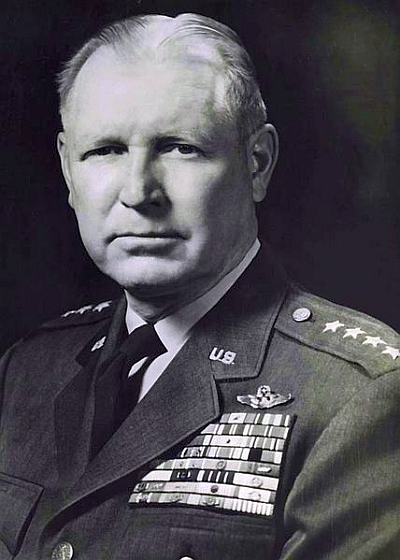
“The Soviets,” he said in an interview, “cannot publicize their
successes because they have continually maintained the position that
only volunteers are participating in the Korean war.
“This would legally divorce Russia from overt identification with
the forces there.”
Shun Publicity
“Publicity on any of the Red pilots as Russian would definitely
detract from the position of the Chinese, who have declared at the
current armistice negotiations that Russia is the most neutral of
neutrals.”
Weyland emphasized that “we have no definite confirmation that any
of the pilots are Russian” beyond pilot reports that “Russian
voices” had been heard on plane radios.
However, the Peiping radio beats its breast over exploits of
Communist tanks, infantrymen and women factory workers. And Weyland
finds it strange that the enemy radio has never invented any air
heroes.
“Perhaps,” he observed, “they don’t have anything to crow about.”
Weyland expressed the thought that pilots of the swift MIG-15 jets
which patrol MIG Alley in northwest Korea are Soviet on some days,
but mostly they are Chinese Communists.
He said he had reason to believe the Communists were using the
skies over North Korea for training fighter pilots.
He estimated there were 700 to 800 Soviet made MIGs operating in the
Korean theater and observed: “They have to be getting a lot of
training to have built up that air force.”
The tall, boyish-looking air general who once
commanded Gen George S. Patton’s air arm in Europe, gave the
interview in his Tokyo office.
An assistant produced official figures up to Feb 23 showing that
Allied jets had shot down 181 MIGs and probably destroyed 27 in air
combat. Allied air combat losses were 43 jets and 15 propeller-driven
planes.
Weyland said Allied news stories may have exaggerated the merits of
the MIG-15 over the U.S. F86 Sabre jet, its chief opponent.
MIG Limitations
“At extremely high altitudes, say above 25,000 to 30,000 feet, the MIG
is better at speed and climb,” he said. “But our boys believe the
MIG has limitations when it comes down lower.”
“There is no question but that the Sabre is stronger and operates
better at lower level. It also has more range. We believe they built
the MIG as an interceptor against our bombers.
“The Chinese air force is built as a defense organization. That
seems to be the whole plan.”
Weyland said he still was investigating reports that “flying
saucers” had been sighted over Korea.
“We can’t say there’s nothing to it,” he added, “but unless we can
get more data, I don’t think we can expect a conclusive answer.”
Two B29 Superfort crews reported seeing orange discs while flying a
night mission recently. One guess was that they might have seen
night flying jets, but Weyland demurred.
“You’d have to be looking right up the tail pipe of a jet to see the glow,”
he said, “and I can’t say that I ever have.”
|
The following letter is from Senator Richard Russell and is found in the Secretary of the Air Force, Office of Information UFO file 1949 to April 1952.
|
Committee on Armed Services February 21, 1952
Honorable Thomas K. Finletter
Secretary of the Air Force Department of the Air Force Washington, D.C.
Dear Mr. Secretary:
Members of the Committee on Armed Services have expressed a desire
to be informed of Air Force evaluation of recent news articles concerning
the observation of "flying saucers" by combat airmen in the Far East.
I shall appreciate you furnishing for the use of the Committee an
official report of these observations together with your evaluation
thereof and such other information as you deem pertinent to this inquiry.
Sincerely,
|
|
SAFIL-3/Maj Turk/jem/5D920/53346/5 Mar 52
File: INV. 155 SUBJECT: Evaluation of Observation of Unidentified Object in the Far East
You recently asked for an evaluation of the observations of an
unidentified object in the Far East as reported in recent news
articles.
This unidentified object was sighted by two Far East Air Forces
B-29 crews on the night of 29-30 January 1952. The crews described
the object as being globe shaped with a slight tear drop effect on
the lower side, light orange in color, occasionally changing to a
bluish tint. One B-29 crew observed the object for 5 minutes while
the second B-29, at a different location and 24 minutes later,
observed a similar object for 1 minute. The size was estimated to
be 3 feet in diameter in both cases, although the distance of the
object from the B-29's could not be determined. The crew members
who reported the sighting were experienced combat men in the Korean
operations as well as World War II veterans.
FEAF was requested to alert bomber crews to the possibility of
similar sightings in the future and to utilize fire control
equipment to determine the distance of these unidentified objects
from the observing aircraft. Thus far there have been no additional
reports.
Based on the meager information available, two tentative
evaluations of these observations have been made:
a. Observation of the exhaust from an La-9 or La-11
Soviet aircraft. The exhaust stacks on both these single-engine
fighters are arranged in a cluster on the side of the fuselage, and
it is believed that the exhaust, when seen at night, would give an
illusion such as described in the report received.
b. There have been several reports in the last few
months of searchlights attached to enemy aircraft which have
intercepted FEAF bombers over Korea. These identifications have
been stated to be positive in most instances. The use of such an
airborne searchlight attached to a conventional aircraft on a very
dark night would be a second possible explanation of the above
incidents. The attention of the crew would most probably be focused
on the light source. This fact, coupled with the difficulty of
discerning the aircraft silhouette under extremely poor light
conditions, could conceivably account for a report of this nature.
N. F. TWINING
General, U.S. Air Force Vice Chief of Staff |
|
SAFIL-3/Maj Turk/msw/SD 920/53346/5 Mar 52
[remainder illegible]
M/R: Ltr fm Sen Russell to Sec Finletter, dtd Feb 21, re recent news articles concerning the observations of flying saucers by combat airmen in the Far East, recd Feb 25/w/sus of Mar 4, acknowledged Feb 26, fwded to Dir of Intelligence for Info upon which to base reply Feb 20, reply recd Mar 4. Final reply prepared and fwded fm Analysis Div on Mar 5, 1952
Mar 8, 1952
Dear Mr. Chairman:
You recently requested us to furnish the Air Force evaluation of recent news articles concerning observation of "flying saucers" by airmen in the Far East.
I have received a report on the matter from the Chief of Staff, which I am forwarding to you.
Sincerely yours,
(Signed) Thomas K. Finletter
Enclosure
Honorable Richard B. Russell Chairman, Committee on Armed Services United States Senate |
|
Director of Legislation and Liaison
ATTN: Analysis Division
Director of Intelligence, DCS/O Col J. G. Eriksen/vb/52466
AFOIN-V/TC
1. In accordance with your request, the following information is submitted:
Colonel, USAF Executive Director of Intelligence
[Hand written: No M/R necessary]
[At the bottom of the second page are the office symbols of the sections of the Directorate of Intelligence and signatures of the responsible officer AFOIN-V [illegible] AFOIN-A B/Gen Garland AFOIN Col Kieling |
Although there were two afternoon sightings of an aggregate of nine MIGs and two night sightings of unidentified type aircraft, all were without incident. Shortly before midnight, however, an extremely unusual sighting took day's activity completely out of the routine. Two B-29 crews reported identical observations of round, sun-colored objects approximately three feet in diameter, which approached each aircraft from the eight to nine o'clock position and flew parallel to the course of the bombers, one of which was travelling at 148 knots ground speed, the other at 125. The object came no closer than an estimated 200 yards in either instance and no hostile or overt action was evident. After a few minutes, the object withdrew to the same clock position from which it approached. In one of the incidents, the disc withdrew until almost out of sight, then returned to again parallel the course of the bomber, after which it pulled away at eight o'clock and disappeared. The two sightings occurred approximately 24 minutes and 63 miles apart and each incident was corroborated by two men on the same aircraft. In each sighting the object was under observation for periods of one to five minutes respectively and was described as brilliant to the point of being almost dazzling. There have been no sightings similar to these since the Korean war began and because of their nature, special effort was made to determine the possibility that the sightings were attributable to causes such as reflections, searchlights, flares, natural phenomena or pure fabrication; however, as yet, no positive estimate has been possible concerning the identity of the objects. Investigation and attempts at evaluation are continuing in the belief that if the objects represent a few from of experimentation by the enemy, in all probability they will be sighted in the near future.

On Aug. 7, 1966, readers of the Washington “Star” had a big surprise
— in fact, several surprises. Before then, any serious discussion of
UFOs in the “Star” was almost unheard of. But there in the Sunday
edition was a full-page fact piece on “flying saucers.”
Surprise No. 2: The article was written by Lt. Col. Charles
Cooke, USAF, Ret., founder and editor of the Air Intelligence Digest.
Col. Cooke, refusing the official explanations, calmly set down his
conclusions that the UFOs are real and from somewhere in outer space.
Colonel Cooke's Air Force service record has other surprises linked
with UFOs. In World War II, he was intelligence officer for a
bombardment group in Europe, where he heard first-hand reports from
pilots who encountered the mysterious “foo fighters.” In 1948-1952,
at the Pentagon, he became the founder and editor of “Air
Intelligence Digest” — the worldwide AF intelligence publication.
Later, in Tokyo, he became editor of FEAF — the “Far East AF
Intelligence Roundup.” During all this time, “information copies” of
steadily increasing UFO reports flowed across his desk.
In 1952, Col. Cooke helped rename “Project Grudge.” Asked to select
a name “without overtones,” he selected “Project Book” - on the
grounds that “book” has so many overtones that it in effect actually
has none.
"The Little Blue Boys”
“Upstairs (at the Joint Chiefs of Staff level), somebody made it
‘Blue Book,'” Col. Cooke reveals. “No one in the USAF assembly line
down which the reports passed read and pondered them more absorbedly,
more dedicatedly, than I. I duly noted the myriad ‘Emanations’ given
out by the Blue Book staff — widely referred to as ‘The Little Boy
Blues' or ‘The Little Blue Boys' — of sightings which they evaluated
as mistakenly identified stars, planets, meteors. . . birds,
reflected lights, mirages, marsh gas — or as delusions. . . hoaxes,
publicity stunts, etc.”
In discussing the massive UFO evidence, Col. Cooke corrects one
of the most widespread false beliefs; That UFO sightings began on
June 24, 1947, with Kenneth Arnold’s famous report of flying discs
over Mt. Rainier. (This idea has long been officially fostered, that
Arnold's story set off the “flying saucer craze.”)
“Far from having begun in 1947,” says Col. Cooke, “reported UFO
sightings go way, way back.”
Commenting on the new Frank Edwards book — “Flying Saucers -
Serious Business” - Cooke says “Edwards book gives me great joy in
its attention to Pre-1947.” Citing one famous case related by
Edwards — a bishop's report of a torpedo-shaped body hovering above
a building - Col. Cooke wryly asks “I can’t help wondering what
Project Blue Book's 'explanation' of this report would have been.
Marsh gas?”
John Fuller’s book, “Incident At Exeter,” also is highly
recommended by Col. Cooke, along with NICAP’s “massive 200,000 word
document, ‘THE UFO EVIDENCE.'” But “Flying Saucers and the U.S.Air
Force,” by Lt. Col. L. J. Tacker, then AF-UFO spokesman, gets a cool
reception.
Considering Col. Cooke's exceptional qualifications, as an
Intelligence analyst, with access to hundreds of the best UFO
reports, his evaluation should have a far-reaching effect:
"My lifelong hobby of astronomy, together with what I consider
to be overwhelming affirmative evidence, incline me toward the
belief that UFOs are ‘real’ and of celestial origin - interplanetary
or interstellar.”
We congratulate the Washington Star for publishing this
authoritative article.
The complete Charles Cooke Washington Star article can be read here. |
|
At 292110/I [29 March 1952 2110 Korean time] over YD 1545 [map
sheet designator], the crew of a B-26 observed 4 dull lights shaped
in a square, approximately 1 mile apart. These lights appeared to be
stationary and suspended at 7000 feet altitude. This observation
was made from 20 miles to within 3 miles at which time the lights
went out. 1 crew member states that he has made the same
observation in the general area on 3 other flights.
a. Comment–No other reports have been received of any such
phenomena in this area. The placement of the lights in a square may
indicate radio long-wire antenna carried by balloons, or a visual
beacon or method of communication.
(EVALUATION: B-3)
[Comments and evaluation made by the Air Technical Intelligence Liaison
Office, Directorate of Intelligence, Far East Air Force.]
|
|
Balloon sightings: At 160210-I of CT 4035, [16 May 1952 0210 am
local Korean time at map coordinates CT 4035] an F-94 crew observed
a balloon approximately 3 feet in diameter. Observation was made by
means of a small light suspended from the balloon. The balloon was
first observed at 13000 feet and the F-94 followed to 24000 feet.
Estimated rate of climb of the balloon was 2000 ft/min, as the F-94
had to use afterburner in the chase. The balloon was shot down over
CT 4610. At 160353-I, vicinity CT 2828 [?], an F-94 crew again
observed a balloon, this time at 12000 feet, again by means of a
steady burning light suspended from the 3 to 6 feet diameter balloon.
Friendly pursued the balloon using afterburner, shooting it down at
CT 4010. The light, described as "Very powerful," was still burning
as the balloon fell. D/I [Director of Intelligence]Comment (5th AF)
- Further investigation is being made by the 6004th AISS [Air
Intelligence Service Squadron].
a. Comment–This report of lighted balloons may be a basis
for many of the sightings reported over this area of Korea.
(EVALUATION: B-2)
Not a case. Information Only Ground Radar, Air Radar, Air Visual Combined Sighting North Korea - 26 May, 1952
An F-94 flying a mission was told by ground radar that there was
an unidentified object on its tail. The interceptor aircraft turned
into the unknown and locked on with its radar at 7000 yds, and
started to close. Both the pilot and the R.O. observed a brilliant white
light straight ahead. The unidentified performed a steady climbing
turn and accelerated at a tremendous speed drawing away from the
F-94 which now had cut in its after-burner. The pilot was unable to
close and the R.O. [radar officer] lost the object at 2600 yds.
after 15 seconds of contact.
The airborne radar was checked for malfunction before and after
the mission and found to be in perfect condition. No exhaust
patterns from the unknown were noticed. Pilot - 1LT John W. Martin,
Radar Officer - Lt. Edward A Monard, Experience - 1 year.
Solution: Possible malfunction of airborne radar set.
Project 1947 Comment: Little information on visual sighting. Did
the person who proposed the solution actually read the
case....ground radar detected the object and it was seen visually.
Also, radar was "was found to be in perfect condition."
At 260323/I over CT 5050 [26 May 1952 0323 local Korean time at
Korea map coordinate of CT 5050] at 7000 feet altitude, an F-94
observed an unidentified aircraft with a very strong light which was
visible from at least 5 miles. The F-94 crew stated that it was
definitely not a balloon as several passes were made directly
beneath at 50ft range. No outline was visible because of the
brilliant light.
a. Comment–There have been a number of balloon sightings over
this area. Reports have also been received of enemy aircraft
carrying searchlights over the Northwest target areas of Korea,
though none have been reported in the CT area.
(EVALUATION: B-3)
[Periodic Intelligence Report] for 27 May, 1952:
At 260320/I [at 26 May 0320 A. M. local Korean time] over CT3930 [map coordinates CT 39 30] at 7599 feet altitude, radar controller vectored an F-94 into a tail chase on an unidentified aircraft. Contact was made at 7000 yards. After closing to 6000 yards, the unidentified picked up speed and travelled from 6000 to 26000 yards in 14 seconds. The F-94 crew said they had afterburner in operation and were accelerating from 250 knots.
D/I [Director of Intelligence] 5th AF Comment - The 6004th AISS [Air Intelligence Service Squadron] is investigating the incident, and if further info is obtained it will be forwarded.
Comment – IF true as reported, the final velocity of the object would be approximately 3000 mph. Further questions, to be used in interrogating the F-94 crew were sent to Fifth Air Force. The results are to be forwarded via Form 112 [Air Intelligence Information Form]
(EVALUATION: B-6)
[Handwritten Comment below this item: "Where's the rest of the report."]
ROK [Republic of Korea. i.e., South Korea] 1st Div Sector: At 302200 [30 May 1000 P. M. local Korean time] forward observer at CT 2226 [military map coordinates CT 22 26] observed flying object emitting streaks of light moving west at high speed at approximately 10,000 feet. Object dived low then regained altitude and continued due west.
a. Comment – No further information is available to date. The object was possibly an F-94.
(EVALUATION: F-6)
|
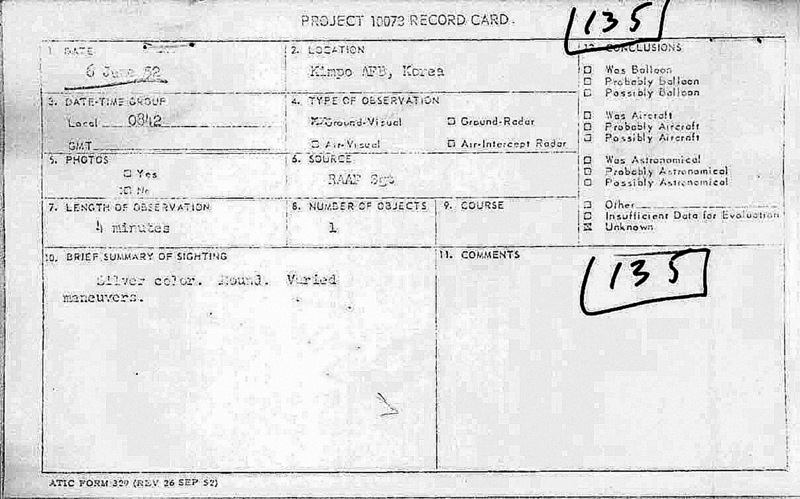
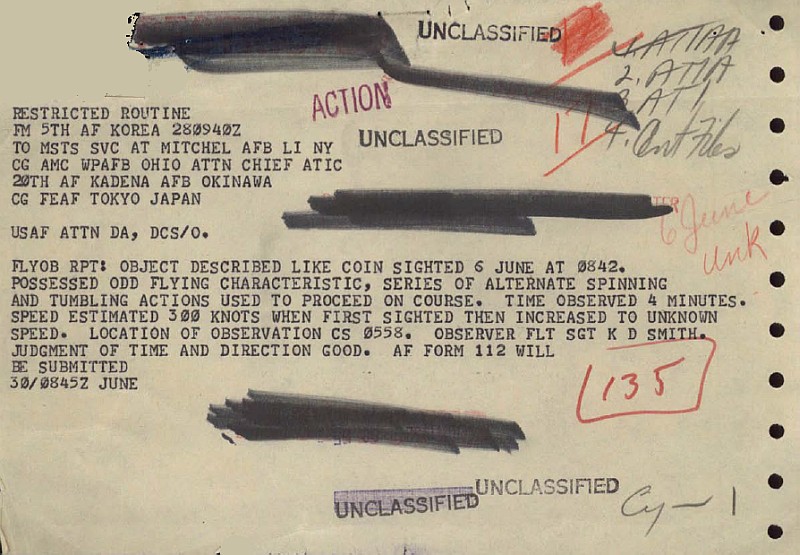
|
COUNTRY
Korea |
REPORT NO
|
LEAVE BLANK
|
AIR INTELLIGENCE INFORMATION REPORT |
||
|
SUBJECT
Sighting of an Unidentified Dlsk Shaped Flying Object |
AREA REPORTED ON
South Korea |
FROM (Agency)
Det 1, 6004th AISS, APO 970 |
|
DATE OF REPORT
28 June 1952 |
DATE OF INFORMATION
|
EVALUATION
|
|
PREPARED BY (Officer)
1st Lt., Gregory B. Burch |
||
|
REFERENCES (Control number, directive, previous report, etc., as applicable)
FLYOBRPT 783 |
||
This report contains information on the ground sighting of a flying object shaped like a coin which was dull silver in color, possessed a high rate of speed and odd flying characteristics. This was described as a series of tumbling and spinning motions. Time required to complete the tumbling was estimated to be seven (7) seconds and the spinning motion an estimated twelve (12) seconds.
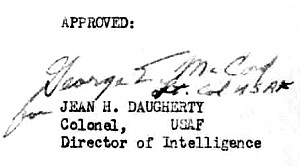
|
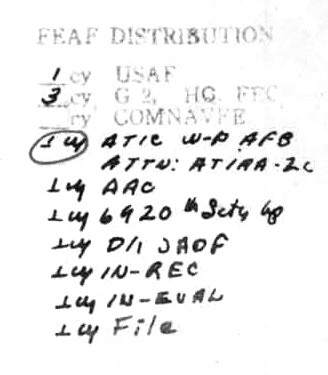
|
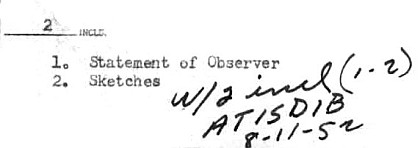
|
|
DISTRIBUTION BY ORIGINATOR
|
DI, FEAF, cy 1
DI, 5th AF, cy 2 CO, 6004th AISS, cy 3 |
ATI, 6004th AISS, cy 4
ATLO, FEAF, cy 5 File, cy 6 |
|
|
||
|
FROM (Agency)
Det 1, 6004th AISS, APO 970 |
REPORT NO
|
Page 2 of 3 PAGES
|
1. Time Sighted: 08:42 zonal time
Length of time sighted: four (4) minutes
Date of sighting: 6 June 1952
2. A brief description of sighted object or objects:
Shape: Round (similar to a coin)
Size: Estimated 50 to 60 feet in diameter.
Color: Silver without any decided reflection of light.
Number of Objects: One.
Trail or exhaust: None observed.
Propulsion System: None observed„
Estimated speed: 300 knots.
Aerodynamic features: Round and flat with clear cut edges. It appeared to be seven times as long as it was thick. The color of the edges was dark blue (twice as dark as sky color), and the top and bottom was silver (dull enough not to reflect any considerable amount of light). On the large surface, which appeared to be the top, several evenly spaced concentric dark or black lines were observed. From this observation the spinning in a clockwise direction was determined (see sketch number one).
Any unusual maneuvers: The object was reported proceeding on a course of approximately 140 degrees, estimated speed of 300 knots, alternately revolving 360 degrees in seven (7) seconds and then proceeding on a spinning course for approximately twelve (12) seconds. This action was observed for approximately three (3) minutes while object approached the field increasing about one half again in size at the point where it paused momentarily. It then climbed straight up for six (6) seconds decreasing one half in size, paused again, picked up a 60 degree heading and began to proceed on a straight course alternately spinning and tumbling in the same manner as before. The object stayed on this course for 40 seconds stopped and then disappeared into the sun. This object was first noticed when the observer saw two F-86’s making a let down into the field on a similar heading of 140 degrees and an altitude of 1500 feet. At one point during this observation the flying object and an F-86 were in the same line of sight giving the observer an opportunity to make a comparison (see sketch number 2). The F-86 was traveling at a faster rate of speed than the object. Sketch number 3 is an illustration of the objects actions. A few seconds later the object was again observed by the original observer and an additional person, flying back and forth just below the position of the sun and traveling an almost equal distance to either side of it. (see sketch number four) The object was seen to pause for approximately five (5) seconds at point A, flew rapidly for three (3) seconds to point B, paused for approximately seven (7) seconds then moved to point C, paused again momentarily and flew rapidly for approximately three (3) seconds to point D and then disappeared. The second observation lasted for an estimated 30 seconds.
Formation if more than one: Negative.
3. Manner of Observation: Visual or electronic: Visual
From air or surface: Surface
Course: Not app Altitude: not app Type of reporting Aircraft: Not app.
Any type of optical or electronic equipment used should be described: None
If radar, the type and whether it was functioning normally before and after the incident: None
Location of observer during the sighting: K-14 Kimpo Air Field, Korea
Location of object relative to observer, giving distance: Unknown
Direction: Heading of 140 degree to 50 degree Altitude: Unknown
|
|
||
|
FROM (Agency)
|
REPORT NO
|
Page OF PAGES
|
Statement of Flight Sergeant Kenneth Dudley Smith, 77th RAAF Squadron - K-14.
I, Flight Sgt. K. D. Smith, witnessed the following event at 0842 hours on 6 June 1952 at Kimpo Airfield, Korea.
An object, first thought to be a piece of paper or a bird, approached the airfield from the North. It was a silver metal disk shaped like a coin which was spinning clockwise as it approached me. It then began to tumble end over end continuing to spin like a large top. I judged it to be approximately 50 to 60 feet in diameter. I based this on an estimated altitude of 8 to 10 thousand feet and the comparison made to the F-86 flying over the field. When first observed it was estimated to be moving at 300 knots against the wind. The object traversed three fourths the airfield, stopped momentarily, then shot straight up, stopped again and changed course 90 degrees to the east. When it reached what I estimate to be 35 to 40 thousand feet it started on the easterly course tumbling in the same manner as before. At one point on this course it paused, changed direction to the South east and disappeared into the sun. I again observed this object a few seconds later flying at a rapid rate of speed back and forth in front of the sun. Another member of my organization, Flight Sgt. Kenneth Fawner, also observed the objects actions at the time of the second sighting. This observation lasted only 30 seconds.
/s/t/ Kenneth Dudley Smith
Flight Sgt.
|
|
||
|
FROM (Agency)
|
REPORT NO
|
Page of PAGES
|
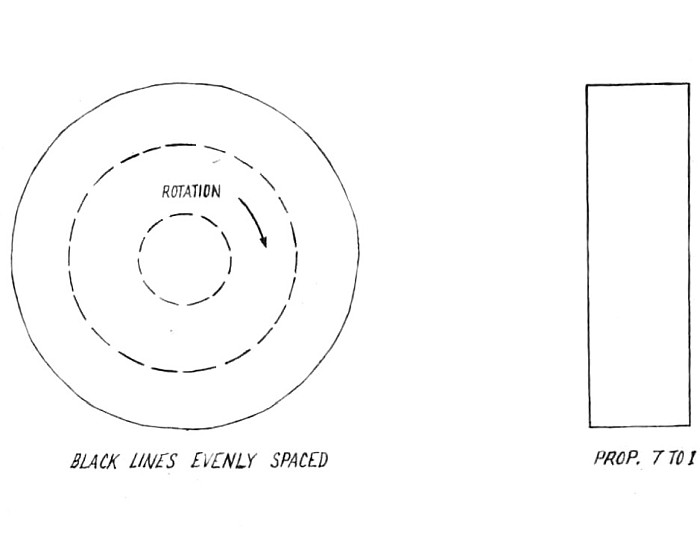
|
|
||
|
FROM (Agency)
|
REPORT NO
|
Page of PAGES
|
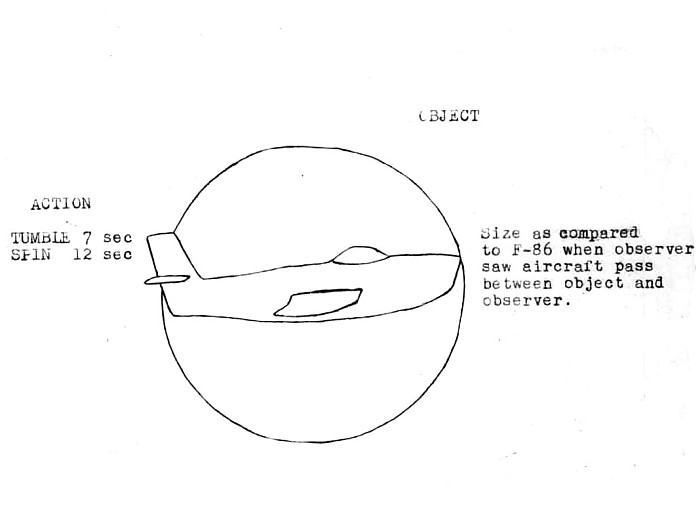
|
|
||
|
FROM (Agency)
Det 1, 6004th AISS, APO 970 |
REPORT NO
|
Page 3 of 3 PAGES
|
Identifying information on observer and witnesses, estimate of reliability and experience and any factor bearing on the estimated reliability of the sighting: Sgt Pilot K.D. Smith performs the duties of a combat pilot in this theater. He has a total of 122 missions, no technical background other than pilot training, two and one half years in military service, and has been in this theater for three and one half months. He was positive in his statements and has good judgment of time.
Weather and wind condition at time of sighting: clear with visibility unlimited.
If sighting was by electronic methods a statement whether any attempt to visually sight the object was made: Negative
Any activity or conditions meteorological or other wise which might account for the sighting: None
Comments of Reporting Officer:
All items included in this report are self explanatory.
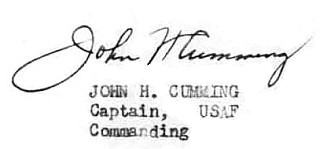
|
D/I FEAF COMMENT:
No further information is available on this reported sighting.
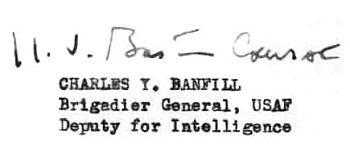
|
|
#717, dtd 0320Z 13 June 1952 [dated 0320 hours Greenwich Mean Time, 13 June 1952]
Enemy balloons: Recently several reports have been received
concerning the sighting of an unidentified object in the air having
a primary color of white changing to red then to green, and located
in the area of DT204398 [Korea military map coordinates DT 204 398].
These observations were made on 10 May and on 4, 6, and 7 June
between the hours of 2102/I and 2400/I [local Korean time]. In the
majority of cases the object was described as being egg shaped or
round, at an altitude estimated between 1000 ft and 10,000 feet, and
in one case was observed through a battery commander's scope [also a
BC-scope] and measured for ten miles travel, but the operator
reported that he could not traverse fast enough to keep on target.
The object was observed on 7 June for 1 hour and 5 minutes by a
trained Air Technical Intelligence specialist and an ordnance
Technical Intelligence specialist. As a result of these
observations, a forward observer investigated the area at 091445/I
June and saw a balloon being raised and lowered on a cable.
DI FEAF [Director of Intelligence Far East Air Force] Comment: Most
of the previous sightings of unidentified objects have occurred in
the CT and DT grid areas. The high horizontal speed of the one
sighting could be accounted for by a free balloon caught in a
horizontal draft in the mountainous areas of that sector. The
purpose of raising and lowering a balloon so near the front lines is
not apparent, but could possibly be a method of communication.
(EVALUATION: B-5)
|
|
Pusan, Sept. 4 (Agence France-Presse)—A "flying saucer" was
supposedly seen today by several persons over Pusan, the temporary
capital of South Korea. This is the second such report in two
months.
According to the witnesses the object of a whitish color, spun
slowly above the city for 11 minutes, then disappeared at a
"terrific" speed.
|
|
(See newspaper clipping mentioning Greene's World War II service.) |
|
On or about Nov 20 1952, while flying the Douglas B-26
(WWII A-26), as a night intruder in Korea, I had the following experience:
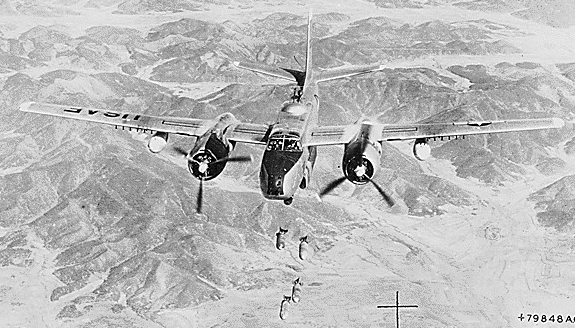
I was involved in interdiction (Covering certain areas behind the
enemy lines with the object of stopping the movement of supplies to
the front). We attacked with bombs or 50 Caliber machine guns as
the case arose. The enemy on this night had a false train engine on
the rails with smoke pots etc. to lure us into expending our Bombs
uselessly. We had made several passes over to examine it when a
very white light appeared 150 feet behind us. It was shaped like a
pear with the small end at the top. It appeared to be six feet tall.
I contacted "Olympic" which was our radar control. They had no
friends or enemies in our vicinity. I asked and was given
permission to attack. We were flying on a heading 90° True (East).
We turned 270° to the left to a heading of
180°, which is due South, and attacked under maximum power.
Without the necessity of banking the object turned instantly to a
180° and was drawing rapidly away. It's (sic) appearance had changed.
There was now a narrow band of red which extended horizontally from
12 to 15 feet wide and in the red reflection from this exhaust, (or
what ever it was) the faint outline of a craft shaped like a saucer
appeared.
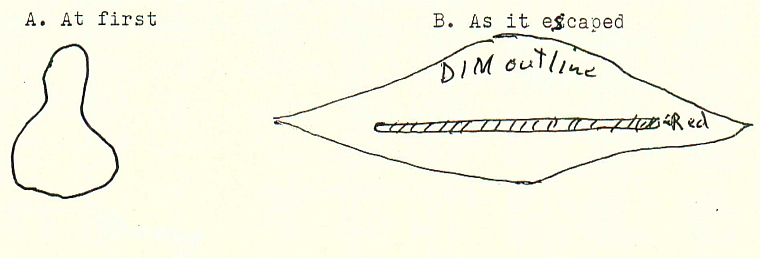 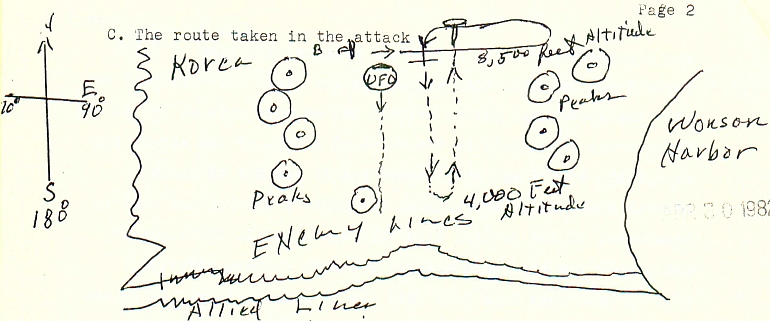
The B-26s were not uniform, (depending upon which depot converted
them.) The one we were flying had the regular four fifty caliber
machine guns in the wings and an additional four in the nose. The
gun switches were accessible only to the radio operator (Who
served also as gunner and a safety co-pilot even though he was not
trained in flying.) Immediately that I launched the attack I
directed the radio operator to turn on the guns and immediately
both radio operator and Navigator/Bombadier (sic) were "blanked out" in
such a way that they could neither talk nor respond in any way.
This lasted one and one half to two minutes. When the crew returned to
reality and the guns were on I fired several bursts at what I judged to
be in excess of 2,000 yards range. As far as I know the shots were
to no effect.
In this part of Korea the terrain was approximately 6,500 feet
above sea level. Our cruising altitude was 8,500 feet, (above the
peaks about 2,000 feet, theoretically.) On this occasion we went
down into a valley between the peaks, did a l80° turn to the left,
away from the nearest peak, as soon as the UFO passed out of view.
We then climbed out on a reciprocal heading of 0° or due North. We
had descended to about 4,000 feet so it was necessary for us to
regain our original altitude of 8,500. I had reasoned that as long
as the craft was visible to us with the space that was in between
us, we were safe as far as the terrain was concerned. At the point
of origin of the attack the fake train engine was still there but
it was out of smoke.
Several hours later we finished the night's mission and went to home base.
We saw nothing else that was unusual. The "blanked" out period was not
remembered by the crew members affected.
I have been told that UFOs are no longer classified in the military and so
now I am free to tell of this encounter.
Theodore S. Greene MajorAFRetRes |
|
UFO ENCOUNTER IN KOREA (INVOLVING ELECTROMAGNETIC EFFECTS AND OCCUPANTS) - MARCH OR APRIL, 1953
A spectacular UFO case has come to light almost exactly ten years
after it happened. NICAP can thank one of its members, Joe Poggi of
Boston, for uncovering the incident and George Nassif of Squantum,
Massachusetts, for revealing it to both Poggi and myself. Although
Nassif did not witness the UFO visually, he heard the sound it
emitted and he states the whole experience is one he will never
forget.
Mr. Nassif, 31, is married, father of two young girls (another child
expected), and lives at 4 Bellevue Road, Squantum, Massachusetts. He
works at the Boston Post Office. Mr. Nassif is in the process of
writing a book about his experiences during the Korean War.
It is interesting to note that the sighting did occur during a
period of increased UFO activity in Korea and Japan. In 1952 and
early 1953 the Air Force received many good reports from those two
countries. The cases involved radar-visual sightings, UFOs following
or pacing jet aircraft or jets pursuing the objects, and UFOs over
Air Force bases. Although an official month-by-month breakdown of
UFO activity is not available for the year 1953, the Air (now
Aerospace) Technical Intelligence Center admitted that during the
first seventeen days of February alone, it received 42 military
reports from bases in the United States and overseas.
Mr. Nassif believes his Korean sighting took place around March or
April, 1953. My files reveal three other UFO cases from Korea, that
happened early in 1953. On February 7 radar picked up an unknown; an
F-94 was scrambled, the pilot saw a bright orange object which
departed at high speed. On April 17 (?) several luminous objects
traveling at speeds of 800 mph were observed (visually?) and tracked
by radar. And on April 19 a triangular object was reported by pilots
of two aircraft. The official intelligence report reads: "At
approximately 1 p.m. today aerial observers in two separate planes
flying routine reconnaissance missions observed a white, rounded,
delta-shaped object. It was estimated to be five to seven feet in
diameter. The observers had no idea of its depth or. thickness. It
was traveling between 60, and 80 mph in a vibrating motion. The
course of flight was north-northeast to south-southwest over enemy
territory.
During this period George Nassif was a supply sergeant stationed at
an Air Force base known as K-8 at Kunsan, Korea.
-2-
This base was used as a back-up installation for other air bases,
and its own B-26s, F-84s, and Marine interceptors conducted bombing
and strafing runs as well as fighter intercept missions. One night,
around 8:00, Sgt. Nassif was returning to his barracks after taking
a shower. Although the sky condition was not noted, the air was
clear and cool and the ground still muddy following rains that had
lasted all week. The base was dark except for a few lights here and
there.
He had just entered the barracks when he suddenly heard a very loud
roaring sound overhead--"like thousands of planes." Everyone (at
least 25 men in the building) thought it was an enemy attack.
Someone yelled "turn off the lights," and everyone hit the floor.
When the roar was gone (after at least a minute) and nothing had
happened, the men got up off the floor. There were plenty of
frightened and mystified faces around, George recalls, including his
own. In the few minutes it took him to put on some clothes and shoes
(no more than two or three minutes, he estimates), the roar was back
and gone again.
The mystery object that caused the noise was also seen, George later
learned from his buddies. Among the eyewitnesses were the control
tower personnel. The first time they reportedly watched the object
come in from the west over the Yellow Sea — like a streak of light — and
then saw it hover momentarily close to the tower. The UFO was
circular, rotating with a strip of light or lights in the middle
section. The object was so close that the towermen could see figures
looking out, according to this second-hand account. The UFO then
picked up speed, passed over the barracks, and proceeded on a
south-easterly course toward Pusan, 140 miles away, where it was
also seen. Radar tracked the object. As a result of the UFO’s
proximity, communications were knocked out at K-8 and apparently at
other points between Kunsan and Pusan. (Knowing the electromagnetic
effects sometimes associated with UFOs, I questioned Mr. Nassif
closely on this point. It is possible that electric power might also
have been affected. Nassif did not actually see anyone turn the
lights off nor did he recall when the lights were on again.)
After a brief visit at Pusan, the object returned to K-8, where it
was once more observed by tower personnel. The UFO headed out over
the sea and disappeared from sight.
In order for the object to have covered the round-trip distance of
280 miles between Kunsan and Pusan in two or three minutes, it would
have had to travel at a speed of 5,600 to 8,400 miles per hour -- and
possibly even faster since Nassif's estimate was no more
than two or three minutes. (This speed is not unusual and is in
keeping with other estimates of UFO velocities. UFO speeds are
typically high.)
-3-
The next morning the topic of discussion around the base was the
mystery aircraft and its terrific roar. Around noon, George
remembers, the base commander Colonel LaBailey ordered everyone at
K-8 to report to the baseball field. There the colonel, standing on
his staff car, addressed the men about the UFO. He told them the
object had knocked out communications, that there was no known enemy
or ...friendly aircraft in the air at the time of the sighting, and
that the object was completely unidentified. He requested everyone
to raise his right hand and take an oath not to discuss the incident
any further and, most importantly, not to write home about it. The
oath was kept because, so far as I know, this is the first report of
this sighting to be released publicly. George Nassif did not tell
anyone about it until after his return to civilian life.
I interviewed Mr, Nassif at my apartment March 13, 1963, with Joe
Poggi present. If this report is published by NICAP, the witness
wishes to have his name omitted from the report. He states that he
will be glad to cooperate in any way if his aid is needed in the
analysis of the sighting.
- Walter N. Webb
|
|
|
|